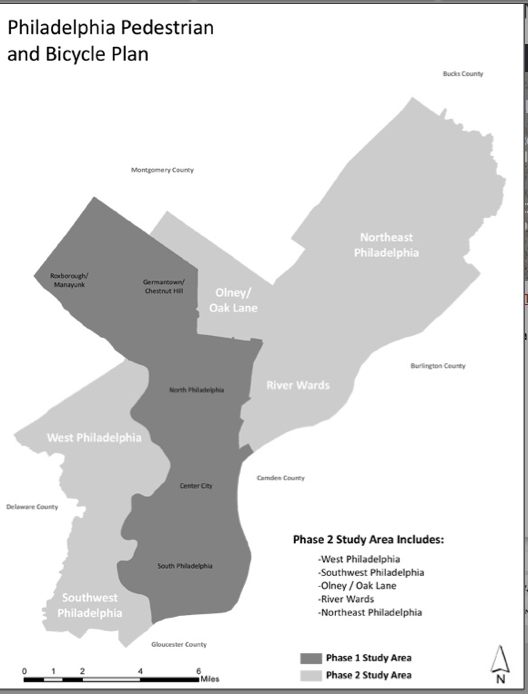Philadelphia gets its first pedestrian plan, which also updates city goals for bicycling.

From now on, Philadelphia streets will not be resurfaced without considering pedestrians and bicyclists.
It’s all part of Philadelphia’s Pedestrian and Bicycle Plan – the first ever for pedestrians and an update to the city’s Bicycle Network Plan, which was completed in 2000.
The first phase of the new plan, was unveiled by planner Deborah Schaaf, plan project manager, at this week’s Philadelphia Planning Commission Meeting. It offers goals for improving conditions for walking and biking in Northwest Philadelphia, North Philadelphia, Center City and South Philadelphia.
“Phase II has already begun,” Schaaf told the commission. This portion will examine and make recommendations for Southwest Philadelphia, West Philadelphia, Olney/Oak Lane, Northeast Philadelphia, and the River Wards, she said.
The plan establishes five over-arching goals: Improving safety for pedestrians and bicyclists. Encouraging biking and walking to promote better health and boost revenue for businesses in walkable, bikeable neighborhoods. Promote sidewalks and streets as enjoyable public space. Filling in the gaps between existing biking and walking networks. Garnering recognition for Philadelphia as a great city for cyclists and pedestrians.
Each goal has standards by which to measure the city’s success. One safety benchmark is to reduce bicyclist and pedestrian fatalities by 50 percent by 2020. The plan seeks to boost the percentage of people using bicycles to commute to work from 1.6 percent to 6.5 percent by 2020, and to increase the percentage of walking commuters from 8.6 percent to 12 percent.
A key part of the plan is the creation of 11 different types of streets, from high-volume pedestrian to auto-oriented commercial/industrial to city neighborhood and scenic drive. For each street type, the plan recommends a total width, the size of the walking zone, and the size of the furnishing zone – that area where things like benches, planters, or structures attached to buildings go.
In areas of low to moderate density, five feet is significant for the walking zone, the report states. Streets with heavy pedestrian volume require eight feet. And streets with “great symbolic importance and major ceremonial functions” – places like Broad Street, Market Street, and the Benjamin Franklin Parkway, a walking zone of 10 feet is a good idea.
The plan also recommends specific changes to benefit pedestrians in specific locations.
One Center City example: The intersection of John F. Kennedy Boulevard and 15th Street. “The major issue for pedestrians at this intersection is conflicts with turning vehicles; specifically, vehicles turning right from 15th onto JFK Boulevard,” the report states. “The width of both streets allows vehicles to maintain higher speeds when turning, and motorists and bicyclists often fail to yield the right of way to pedestrians.”
Suggested fixes include changing the walk signal so that pedestrians get to start crossing JFK Boulevard before cars traveling on 15th Street can proceed through the intersection; installing an additional pedestrian island on 15th Street and reinforcing the message that drivers should take pains not to get stuck in the intersection when the signal changes with an education campaign and street pavement markings.
The plan also recommends five different ways for streets to accommodate cyclists. There are several kinds of bike lanes, including separate lanes on either side of a two-way street; contra-flow lanes which allow bikes to travel in both directions on streets in which cars go one-way only; climbing bike lanes which offer a separate lane for bikes in the uphill direction but a shared bike and vehicle lane going downhill; and bicycle-friendly streets where cars and bikes share the street, but there is not enough space for vehicles to pass bicycles.
The first phase of the plan calls for adding about 60 miles of bike-only lanes to Philadelphia’s 200 + miles, Schaaf said.
The goal, she said, is the creation of “complete streets” – streets that serve motor vehicles, bicyclists and pedestrians equally well.
The Planning Commission did not need to vote on the plan, but several commissioners asked questions. A few focused on problems with bicyclists riding on sidewalks – something that is illegal in Philadelphia.
Many cyclists don’t realize riding on sidewalks is illegal, and so more education is needed, Schaaf said. Deputy Mayor and Commission Chairman Alan Greenberger said that implementing the pedestrian and bike plan would go a long way toward reducing problems, because it would give cyclists safer places to ride. “Now, if you tell someone they shouldn’t be riding on the sidewalk, the question is, ‘where should I ride?’” he said.
For many more details on the plan, including highly detailed maps, charts and graphics, go the the the plan website.
The website also gives information about upcoming public meetings on Phase II of the plan. There is one at the Kingsessing Branch Public Library from 5 p.m. to 7 p.m. tonight, Oct. 21.
The Commission also heard updates on and/or took action on several other items at this week’s meeting, including an information-only presentation about an entertainment venue proposed for 2055 Richmond Street in Fishtown, the rezoning of a parcel of land at the foot of the Ben Franklin Bridge that would allow for a hotel with a large restaurant and entertainment space on the ground floor and an electronic sign that would provide advertising that developers do not want to call a billboard. Learn about these and other items from the videos below:
PCPC report
2055 Richmond Street entertainment venue
Holy Family master plan
Proposed mixed-use development at Race Street
WHYY is your source for fact-based, in-depth journalism and information. As a nonprofit organization, we rely on financial support from readers like you. Please give today.






